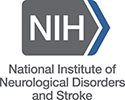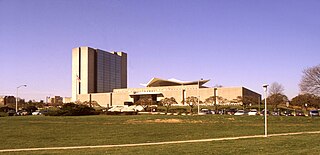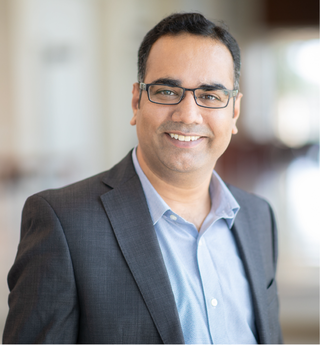
The National Institutes of Health, commonly referred to as NIH, is the primary agency of the United States government responsible for biomedical and public health research. It was founded in the late 1880s and is now part of the United States Department of Health and Human Services. Many NIH facilities are located in Bethesda, Maryland, and other nearby suburbs of the Washington metropolitan area, with other primary facilities in the Research Triangle Park in North Carolina and smaller satellite facilities located around the United States. The NIH conducts its own scientific research through the NIH Intramural Research Program (IRP) and provides major biomedical research funding to non-NIH research facilities through its Extramural Research Program.

The National Institute of Neurological Disorders and Stroke (NINDS) is a part of the U.S. National Institutes of Health (NIH). It conducts and funds research on brain and nervous system disorders and has a budget of just over US$2.03 billion. The mission of NINDS is "to reduce the burden of neurological disease—a burden borne by every age group, every segment of society, and people all over the world". NINDS has established two major branches for research: an extramural branch that funds studies outside the NIH, and an intramural branch that funds research inside the NIH. Most of NINDS' budget goes to fund extramural research. NINDS' basic science research focuses on studies of the fundamental biology of the brain and nervous system, genetics, neurodegeneration, learning and memory, motor control, brain repair, and synapses. NINDS also funds clinical research related to diseases and disorders of the brain and nervous system, e.g. AIDS, Alzheimer's disease, epilepsy, muscular dystrophy, multiple sclerosis, Parkinson's disease, spinal cord injury, stroke, and traumatic brain injury.

The United States National Library of Medicine (NLM), operated by the United States federal government, is the world's largest medical library.
The National Institute of Mental Health (NIMH) is one of 27 institutes and centers that make up the National Institutes of Health (NIH). The NIH, in turn, is an agency of the United States Department of Health and Human Services and is the primary agency of the United States government responsible for biomedical and health-related research.
The National Institute of Arthritis and Musculoskeletal and Skin Diseases (NIAMS) is one of the institutes and centers that make up the National Institutes of Health, an agency of the United States Department of Health and Human Services (HHS).
The National Heart, Lung, and Blood Institute (NHLBI) is the third largest Institute of the National Institutes of Health, located in Bethesda, Maryland, United States. It is tasked with allocating about $3.6 billion in FY 2020 in tax revenue to advancing the understanding of the following issues: development and progression of disease, diagnosis of disease, treatment of disease, disease prevention, reduction of health care disparities within the American population, and advancing the effectiveness of the US medical system. NHLBI's Director is Gary H. Gibbons (2012–present).
The National Cancer Institute (NCI) coordinates the United States National Cancer Program and is part of the National Institutes of Health (NIH), which is one of eleven agencies that are part of the U.S. Department of Health and Human Services. The NCI conducts and supports research, training, health information dissemination, and other activities related to the causes, prevention, diagnosis, and treatment of cancer; the supportive care of cancer patients and their families; and cancer survivorship.
The National Institute of Allergy and Infectious Diseases is one of the 27 institutes and centers that make up the National Institutes of Health (NIH), an agency of the United States Department of Health and Human Services (HHS). NIAID's mission is to conduct basic and applied research to better understand, treat, and prevent infectious, immunologic, and allergic diseases.
The National Institute on Aging (NIA) is a division of the U.S. National Institutes of Health (NIH), located in Bethesda, Maryland. The NIA itself is headquartered in Baltimore, Maryland.
A computational model uses computer programs to simulate and study complex systems using an algorithmic or mechanistic approach and is widely used in a diverse range of fields spanning from physics, engineering, chemistry and biology to economics, psychology, cognitive science and computer science.
The National Center for Research Resources (NCRR) was a center within the National Institutes of Health, a United States government agency. NCRR provided funding to laboratory scientists and researchers for facilities and tools in the goal of curing and treating diseases.

Bruce J. Tromberg is an American photochemist and a leading researcher in the field of biophotonics. He is the director of the National Institute of Biomedical Imaging and Bioengineering (NIBIB) within the National Institutes of Health (NIH). Before joining NIH, he was Professor of Biomedical Engineering at The Henry Samueli School of Engineering and of Surgery at the School of Medicine, University of California, Irvine. He was the principal investigator of the Laser Microbeam and Medical Program (LAMMP), and the Director of the Beckman Laser Institute and Medical Clinic at Irvine. He was a co-leader of the Onco-imaging and Biotechnology Program of the NCI Chao Family Comprehensive Cancer Center at Irvine.
Shuvo Roy is an American scientist and engineer of South Asian descent.

The NIH Intramural Research Program (IRP) is the internal research program of the National Institutes of Health (NIH), known for its synergistic approach to biomedical science. With 1,200 Principal Investigators and over 4,000 Postdoctoral Fellows conducting basic, translational, and clinical research, the NIH Intramural Research Program is the largest biomedical research institution on earth. The unique funding environment of the IRP facilitates opportunities to conduct both long-term and high-impact science that would otherwise be difficult to undertake. With rigorous external reviews ensuring that only the most outstanding research secures funding, the IRP is responsible for many scientific accomplishments, including the discovery of fluoride to prevent tooth decay, the use of lithium to manage bipolar disorder, and the creation of vaccines against hepatitis, Hemophilus influenzae (Hib), and human papillomavirus (HPV). In addition, the IRP has also produced or trained 21 Nobel Prize-winning scientists.
The Case Western Reserve University Department of Biomedical Engineering launched in 1968 as one of the first biomedical engineering programs in the world. Formally incorporated in both the School of Engineering and School of Medicine, the department provides full research and education programs and is consistently top-ranked for graduate and undergraduate studies, according to U.S. News & World Report.

Roderic Ivan Pettigrew is an American physicist, engineer, and physician who is CEO of EnHealth and Executive Dean for EnMed at Texas A&M University. From 2002-November 2017, he was the founding director of the National Institute of Biomedical Imaging and Bioengineering (NIBIB) at the National Institutes of Health (NIH). He is a pioneer and world expert in cardiovascular magnetic resonance imaging (MRI).

Akhilesh K. Gaharwar is an Indian academic and a professor in the Department of Biomedical Engineering at Texas A&M University. The goal of his lab is to understand the cell-nanomaterials interactions and to develop nanoengineered strategies for modulating stem cell behavior for repair and regeneration of damaged tissue.

Marie Ussing Nylen is a Danish-American biologist, dentist, microscopist, and badminton player known for her research on the morphology of tooth enamel and her contributions to refining the electron microscope as an aide in dental research at the National Institute of Dental and Craniofacial Research (NIDR). She was the first woman director of the NIDR's Intramural Research Program. Nylen became director of the NIDR extramural research program in 1984. In 1947 and 1953, she won the women's world singles event at the All England Open Badminton Championship.

Kaitlyn Noelle Sadtler is an American immunologist and bioengineer and Stadtman Tenure-Track Investigator at the National Institute of Biomedical Imaging and Bioengineering, known for completing the first population-wide serosurvey during the COVID-19 pandemic in the United States in 2020.
Catherine M. Klapperich is an American biomedical engineer noted for her research on diagnostics and precision medicine. She is currently professor of biomedical engineering at Boston University, with additional appointments in materials science & engineering and mechanical engineering. Klapperich serves as the director of research for the DAMP Laboratory at BU. Klapperich was previously the director of the NIH NIBIB Center for Future Technologies in Cancer Care as part of the Point-of Care-Research Technologies Network.















